Nov. 11 to Nov. 17
People may call Taipei a “living hell for pedestrians,” but back in the 1960s and 1970s, citizens were even discouraged from crossing major roads on foot. And there weren’t crosswalks or pedestrian signals at busy intersections.
A 1978 editorial in the China Times (中國時報) reflected the government’s car-centric attitude: “Pedestrians too often risk their lives to compete with vehicles over road use instead of using an overpass. If they get hit by a car, who can they blame?”
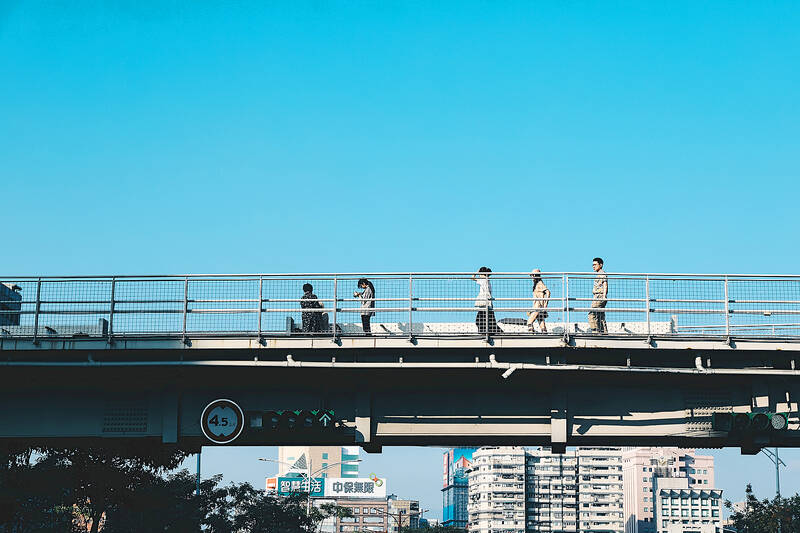
Photo courtesy of weichen_kh vis Flickr
Taipei’s car traffic was growing exponentially during the 1960s, and along with it the frequency of accidents. The policy was to prioritize the efficiency of motorized vehicles, which meant getting pedestrians off the roads. In 1965, the city built its first pedestrian underpass next to the old Taipei Zoo in Yuanshan, which burrowed across the busy Zhongshan North Road. Three years later in March 1968, the first overpass, or “sky bridge” (天橋) appeared across today’s Zhongxiao West Road by the North Gate.
These structures multiplied across the city, many of them around schools, at one point numbering more than 110. They weren’t just passageways, but an integral part of the urban landscape that left a lasting imprint on those who used them daily. Vendors hawked their wares there, and salespeople used them to approach passersby. Beggars were also common. At a time when Taipei didn’t have many tall buildings, they served as vantage points to watch the sunset or snap photos, protesters hung banners on them and they also appeared in countless novels, movies and music videos. In later years they were also touted as exhibition and performance spaces.
With the shift toward humanistic traffic planning in the 2000s, coupled with the deterioration in appearance and structure of many of the overpasses, the city began tearing them down. So far, 41 have been removed.

Photo: CNA
Even though people no longer used them, they still often protested the demolitions due to the special place the bridges had in their memories. Over the past week, residents have rallied against the Taipei City Government’s plan to destroy the 42-year-old Xinsheng Heping overpass by Daan Forest Park, which was scheduled to begin on Nov. 4. Although work has been delayed, at the time of writing the city seems intent on pushing through, noting that the usage rate of the structure is only at around 10 percent.
CHARITABLE ACT
On Dec. 9, 1968, just nine months after the first sky bridge came up, students at Yongle (永樂) and Taiping (太平) elementary schools cheered loudly as the mayor inaugurated the Pingle overpass (平樂陸橋) at Yanping N Road and Liangzhou Street. Yanping was one of Taipei’s busiest streets then, and finally the children had a safe way to cross it. Today, it’s Taipei’s oldest surviving sky bridge.
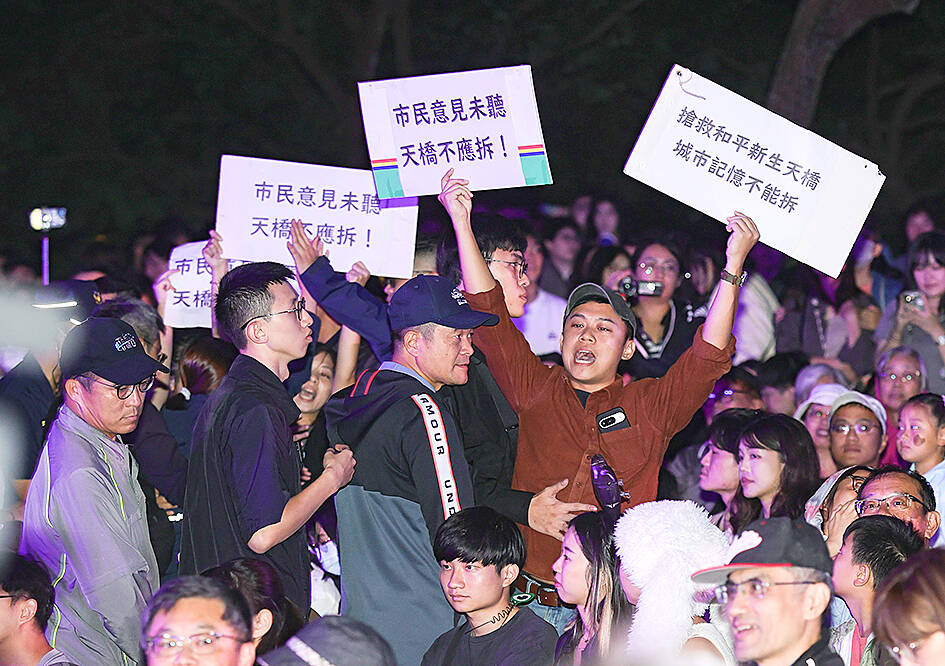
Photo: CNA
The VIP of the ceremony was Yu Chun-cheng (游俊成), a neighborhood resident who donated NT$400,000 (about NT$3 million today) to build the bridge, amounting to two-thirds of the total costs.
A United Daily News (聯合報) report states that Yu had witnessed a tragic traffic accident three years earlier and vowed to save up to do something that would help pedestrians. He provided blueprints to the city and specified the location, noting that the intersection was like the “mouth of a tiger” to the area’s numerous students.
After this, a good portion of Taipei’s overpasses were built near schools for student use; sometimes schools even paid for their construction.
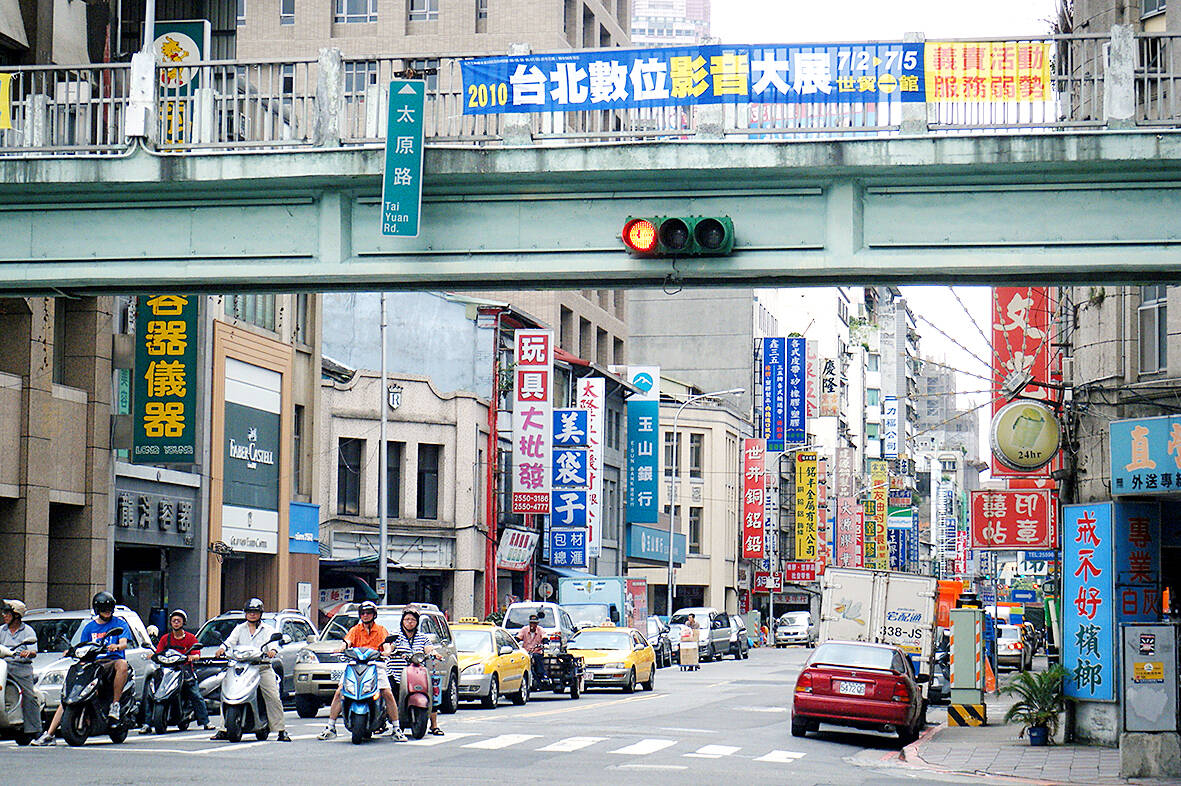
Photo courtesy of Wikimedia Commons
It was a rapid transition; just a decade earlier Taipei’s street traffic mostly consisted of pedestrians, bicycles, pedicabs and oxcarts. The government began phasing out pedicabs during the early 1960s and encouraged drivers to switch to taxis, and the number of motorized vehicles multiplied from then.
At this time, Taipei entered a “road building frenzy,” writes Hsiao Yao-chi (蕭珧綺) in “Passage, Vision and Place: The Production and Construction of Pedestrian Bridges in Taipei” (通道,觀視與地方:台北市天橋的生產與建構). But without much of a comprehensive plan, the city’s traffic quality plummeted and accidents soared. Their solution was to keep human and vehicle traffic separate.
“As overpasses have been completed in the busy areas of the city, it’s reasonable for the police to hope that people will use them … Humans are at a disadvantage when competing against cars, and face serious safety concerns. With the overpasses, now people will walk above, cars will pass below and everybody wins,” a July 1968 Central Daily News (中央日報) editorial stated.
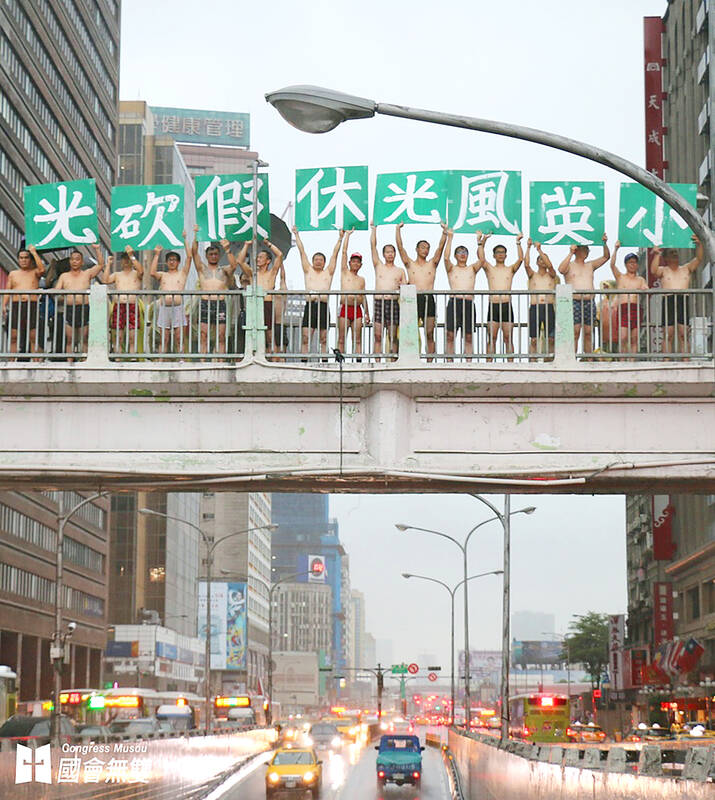
Photo courtesy of Wikimedia Commons
PEDESTRIANS FIRST
Most of Taipei’s overpasses were built between 1970 and 1982, and the practice soon spread to other cities, Hsiao writes. But the traffic situation continued to worsen.
The city had to do something about it; they began planning the MRT system and moving the railroad underground. In 1990, the city designated bus-only lanes to increase their efficiency so that more people would use public transport. This inadvertently reduced the use of overpasses as people had to go to the middle of the road to catch the bus.
In 1997, the city released its first traffic plan that put pedestrians first under then-department of transportation director Hochen Tan (賀陳旦). He limited the permits for new overpasses and underpasses, and established crosswalks and added pedestrian signals at major intersections. The city also began clearing up the sidewalks and cracked down on those who blocked them. With these measures, overpass use declined.
It didn’t help that these structures were not well-maintained; the anti-slip treads of the stone stairs wore out to the point that they became hazards — a 1989 United Daily News article even called the steps “murder weapons.” People criticized them for being unfriendly to disabled people or elderly — a few elevators were built but the city soon realized it was not worth the cost. Politicians argued that they were costly to maintain.
During the late 1990s, the city attempted to repurpose the bridges into cultural spaces, Hsiao writes, and then-mayor Chen Shui-bian (陳水扁) in 1998 expressed his hope that they could become “open-air museums and concert halls.” But that wasn’t enough to save them.
The first overpasses to be removed were for practical purposes, either due to the railroad moving underground or MRT construction. No more were built after 2008, and in 2016 the city began tearing them down in earnest.
Taiwan in Time, a column about Taiwan’s history that is published every Sunday, spotlights important or interesting events around the nation that either have anniversaries this week or are tied to current events.

April 14 to April 20 In March 1947, Sising Katadrepan urged the government to drop the “high mountain people” (高山族) designation for Indigenous Taiwanese and refer to them as “Taiwan people” (台灣族). He considered the term derogatory, arguing that it made them sound like animals. The Taiwan Provincial Government agreed to stop using the term, stating that Indigenous Taiwanese suffered all sorts of discrimination and oppression under the Japanese and were forced to live in the mountains as outsiders to society. Now, under the new regime, they would be seen as equals, thus they should be henceforth

Last week, the the National Immigration Agency (NIA) told the legislature that more than 10,000 naturalized Taiwanese citizens from the People’s Republic of China (PRC) risked having their citizenship revoked if they failed to provide proof that they had renounced their Chinese household registration within the next three months. Renunciation is required under the Act Governing Relations Between the People of the Taiwan Area and the Mainland Area (臺灣地區與大陸地區人民關係條例), as amended in 2004, though it was only a legal requirement after 2000. Prior to that, it had been only an administrative requirement since the Nationality Act (國籍法) was established in

Three big changes have transformed the landscape of Taiwan’s local patronage factions: Increasing Democratic Progressive Party (DPP) involvement, rising new factions and the Chinese Nationalist Party’s (KMT) significantly weakened control. GREEN FACTIONS It is said that “south of the Zhuoshui River (濁水溪), there is no blue-green divide,” meaning that from Yunlin County south there is no difference between KMT and DPP politicians. This is not always true, but there is more than a grain of truth to it. Traditionally, DPP factions are viewed as national entities, with their primary function to secure plum positions in the party and government. This is not unusual
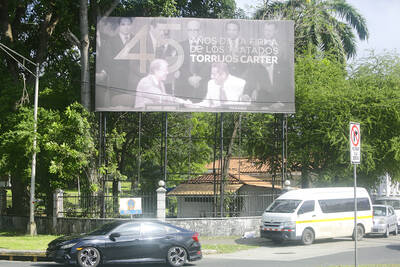
US President Donald Trump’s bid to take back control of the Panama Canal has put his counterpart Jose Raul Mulino in a difficult position and revived fears in the Central American country that US military bases will return. After Trump vowed to reclaim the interoceanic waterway from Chinese influence, US Defense Secretary Pete Hegseth signed an agreement with the Mulino administration last week for the US to deploy troops in areas adjacent to the canal. For more than two decades, after handing over control of the strategically vital waterway to Panama in 1999 and dismantling the bases that protected it, Washington has